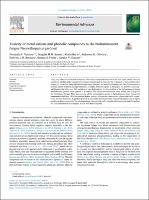Please use this identifier to cite or link to this item:
https://hdl.handle.net/20.500.12202/9625| Title: | Toxicity of metal cations and phenolic compounds to the bioluminescent fungus Neonothopanus gardneri |
| Authors: | Ventura, Fernanda F. Soares, Douglas M.M. Bayle, Kevin Oliveira, Anderson G. Bechara, Etelvino J.H. Freire, Renato S. Stevani, Cassius V. 0000-0003-1752-0726 |
| Keywords: | Bioassay Basidiomycete Fungicide development Soil ecotoxicology Tropical ecotoxicity |
| Issue Date: | 2021 |
| Publisher: | ScienceDirect |
| Citation: | Fernanda F. Ventura, Douglas M.M. Soares, Kevin Bayle, Anderson G. Oliveira, Etelvino J.H. Bechara, Renato S. Freire, & Cassius V. Stevani. (2021). Toxicity of metal cations and phenolic compounds to the bioluminescent fungus Neonothopanus gardneri. Environmental Advances, 4(100044-). https://doi.org/10.1016/j.envadv.2021.100044 |
| Series/Report no.: | Environmental Advances;4 |
| Abstract: | Fungi play a key role in the soil ecosystem, where they occupy the first level of the food chain. Hence, they are considered suitable model organisms to conduct ecotoxicological assays for the evaluation of soil condition after proper soil extraction. Fungi bioluminescence-based bioassays are useful considering that their luminescence is an early toxicity endpoint and light emission a promptly detectable signal. In this paper, we describe a toxicological bioassay that relies on a 24-h variation of total light emitted by the mycelium of the bioluminescent fungus Neonothopanus gardneri when exposed to a toxicant. The current bioluminescent assay, which uses a fungus of the Omphalotus lineage, fills a gap covering all the representative species of bioluminescent fungi. Among the compounds tested here, Cd(II) showed the highest toxicity, followed by 4-nitrophenol, phenol and Cu(II), respectively. We also found that N. gardneri presents a predictable bioluminescence and growth pattern, and is highly sensitive to these compounds. The aforementioned characteristics offer valuable advantages and make N. gardneri the ideal candidate for toxicological studies with basidiomycetes. |
| Description: | Scholarly article / Open access |
| URI: | https://hdl.handle.net/20.500.12202/9625 |
| Appears in Collections: | Stern College for Women -- Faculty Publications |
Files in This Item:
| File | Description | Size | Format | |
|---|---|---|---|---|
| Oliveira OA 2021 Toxicity of metal 1-.pdf | 786.19 kB | Adobe PDF |  View/Open |
This item is licensed under a Creative Commons License

